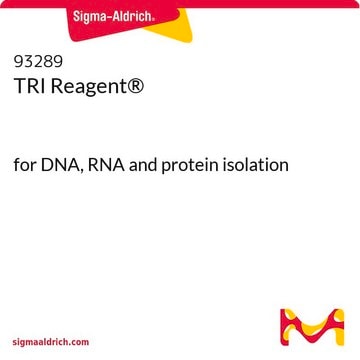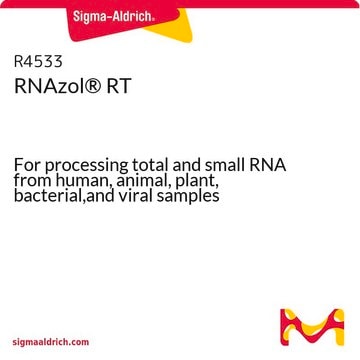This product is intended to simply maintain the integrity of the DNA and RNA during extraction and does not play a role in the disruption or digestion of the sample. Both, large and small nucleic acid molecules will be recovered. The primary factor in determining the size of the recovered nucleic acid fragments will be the method utilized to disrupt the cells or tissues.
T9424
Reactivo TRI®
For processing tissues, cells cultured in monolayer or cell pellets
Sinónimos:
Reactivo para aislamiento de ARN TRI Reagent®
About This Item
Productos recomendados
Quality Level
usage
mL sufficient for 107 cells
mL sufficient for 100 mg tissue (or)
storage temp.
2-8°C
¿Está buscando productos similares? Visita Guía de comparación de productos
General description
La homogeneización o lisis de la muestra de tejido en el reactivo TRI® disuelve el ARN, el ADN y las proteínas. La adición de cloroformo o 1-bromo-3-cloropropano seguida de centrifugación produce la separación en tres fases: una fase acuosa que contiene el ARN, la interfase que contiene el ADN y una fase orgánica que contiene las proteínas. A continuación, puede aislarse cada uno de los componentes después de separar las fases.
Application
- en el aislamiento del ARN total de varias muestras de tejido y células [1][2][3][4]
- para la lisis de monocitos [5]
- para aislar el ARN citoplasmático de las células Vero infectadas por el SARS-CoV [6]
- para aislar el ARN total de MDM (macrófagos derivados de monocitos) infectados por el virus de la gripe A (H5N1) [7]
- para preparar un lisado vírico de cultivo de SARS-CoV con objeto de crear un clon que codifique la glucoproteína S en el desarrollo de la vacuna contra el SARS-CoV [8]
El ARN, el ADN y las proteínas que se aíslan con el reactivo TRI® pueden utilizarse para aplicaciones posteriores, como clonación, PCR, RT-PCR, aislamiento del ARNm, traducción in vitro, ensayo de protección de ARNasas, digestión con enzimas de restricción, SDS-PAGE y técnicas northern, Southern y Western.
Features and Benefits
Multiuso: el rendimiento del reactivo TRI® es bueno con cantidades grandes o pequeñas de tejido o células; el reactivo funciona con muchos tipos de muestras, como las humanas, vegetales, bacterianas, víricas y de levaduras.
Eficiencia: el reactivo TRI® proporciona mejores rendimientos que los métodos tradicionales de tiocianato de guanidina o cloruro de cesio. El proceso completo de extracción del ARN desde el tejido o las células frescas, puede completarse en menos de una hora.
- Aislamiento del ARN fácilmente escalable
- Funciona con muchos orígenes: humano, vegetal, levaduras, bacterias o vírico
- Mejor rendimiento que los métodos tradicionales de tiocianato de guanidina/cloruro de cesio
Legal Information
related product
signalword
Danger
Hazard Classifications
Acute Tox. 3 Dermal - Acute Tox. 3 Inhalation - Acute Tox. 3 Oral - Aquatic Chronic 2 - Eye Dam. 1 - Muta. 2 - Skin Corr. 1B - STOT RE 2
target_organs
Nervous system,Kidney,Liver,Skin
supp_hazards
Storage Class
6.1A - Combustible acute toxic Cat. 1 and 2 / very toxic hazardous materials
wgk_germany
WGK 2
flash_point_f
174.2 °F - closed cup
flash_point_c
79 °C - closed cup
Elija entre una de las versiones más recientes:
¿Ya tiene este producto?
Encuentre la documentación para los productos que ha comprado recientemente en la Biblioteca de documentos.
Los clientes también vieron
Artículos
Simple DNA/RNA purification methods aid genome analysis from various sources, enhancing research efficiency.
Protocolos
Procedure and protocol for Anti Ago-RNA Immunoprecipitation from mammalian cells using the RIP kit
TRI Reagent enables simultaneous DNA, RNA, and protein isolation with sample prep guidelines and troubleshooting.
Learn Northern and Southern blotting basics, with protocols and applications for macromolecule transfer to membrane supports.
Contenido relacionado
An overview of cell lysis and protein extraction methods including detergent solubilization, freeze-thaw lysis, osmotic shock, sonication, enzymatic cell lysis, and mechanical disruption techniques such as Dounce, Polytron, and mortar and pestle homogenization.
Cell lysis and protein extraction methods overview various techniques, from detergent solubilization to mechanical disruption, supporting research needs.
Los métodos de lisis celular y extracción de proteínas abarcan varias técnicas, desde la solubilización de detergentes hasta la ruptura mecánica, que respaldan las necesidades de investigación.
-
what is the size(kb) of the trizol extracted DNA?
1 answer-
Helpful?
-
-
Using trizol in isolation gDNA from nuclei (from plant). After extracting nuclei, pellet(nuclei) is dissolved in 1.6-6.4mL TE buffer and incubated with SDS and Proteinase K. Next is trizol, what is the ratio of trizol to add to this liquid sample?
1 answer-
As mentioned in the product bulletin, "the volume of the tissue should not exceed 10% of the volume of the TRI Reagent." For a sample volume range of 1.6 ml to 6.4 ml, you would need to add a minimum of 16 ml to 64 ml of Tri Reagent.
Please see the link below for more information: https://www.sigmaaldrich.com/deepweb/assets/sigmaaldrich/product/documents/294/543/t9424bulletin.pdfHelpful?
-
-
Does trizol have SDS in it?
1 answer-
As mentioned in the 'DESCRIPTION' section under 'General Description', TRI reagent® is a mixture of guanidine thiocyanate and phenol in a monophasic solution. This product does not contain SDS.
Helpful?
-
-
How long can samples be stored in TRI Reagent at -80°C?
1 answer-
Prior to phase separation, TRI Reagent-treated tissue extracts can be stored at -80 °C for years without demonstrable negative effects on
recovered RNA quality or quantity. Although salt precipitation following freezing has not been observed, the investigator must make sure that any
salts that may precipitate from the solution during the freeze-thaw cycle are resolubilized before using proceeding.See the link below to review the product datasheet, including protocols:
https://www.sigmaaldrich.com/deepweb/assets/sigmaaldrich/product/documents/294/543/t9424bulletin.pdfHelpful?
-
-
What is the Department of Transportation shipping information for this product?
1 answer-
Transportation information can be found in Section 14 of the product's (M)SDS.To access the shipping information for this material, use the link on the product detail page for the product.
Helpful?
-
-
Can I use T9424 Tri Reagent™ for blood samples?
1 answer-
No, we recommend using T3809 Tri Reagent BD for work in blood samples.
Helpful?
-
-
My cells are plated on polystyrene culture plates. How do I use Product T9424, TRI Reagent in this application?
1 answer-
We recommend harvesting the cells in PBS with a rubber policeman/cell scraper, transfer to an eppendorf tube, and proceed with the RNA isolation by removing the PBS from the cell pellet and re-suspending the pellet in the Tri Reagent.
Helpful?
-
-
Which chloroform and isopropanol do you recommend to be used with T9424, Tri Reagent™?
1 answer-
For chloroform and isopropanol we recommend C2432 and I9616, respectively.
Helpful?
-
-
If I add a volume of Product T9424, Tri Reagent™, different from 1 ml, how much chloroform and isopropanol should I add?
1 answer-
What is important is to keep the ratio the same. For example, we recommend adding 200 μL of chloroform and 500 μL of isopropanol when using 1 ml of Tri Reagent. Therefore, 100 μL of chloroform and 250 μL of isopropanol would be added if using 500 μL of Tri Reagent. Similarly, 300 μL of chloroform and 750 μL of isopropanol would be added to if using 1.5 ml of Tri Reagent.
Helpful?
-
-
What is the expiration date for Product T9424, Tri Reagent™?
1 answer-
The expiration date for T9424 has not been established. However, based on our storage guidelines, it should be usable for 1 year from the date of receipt.
Helpful?
-
Active Filters
Nuestro equipo de científicos tiene experiencia en todas las áreas de investigación: Ciencias de la vida, Ciencia de los materiales, Síntesis química, Cromatografía, Analítica y muchas otras.
Póngase en contacto con el Servicio técnico
















